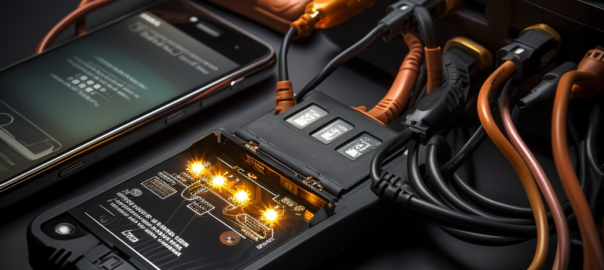As our reliance on battery-powered devices grows, understanding the thermal considerations of battery systems is becoming increasingly critical. Be it in electric vehicles, renewable energy storage, or mobile devices, both Lithium-Ion and Lead-Acid batteries serve as integral components. However, each type presents unique thermal challenges that require careful management to ensure optimal performance, longevity, and most importantly, safety.
This article aims to provide an exhaustive guide on the thermal considerations of these two types of batteries, focusing on the principles of expertise, authoritativeness, and trustworthiness. You’ll learn about the basic chemistry behind these batteries, what causes them to generate heat, and the critical thermal considerations to be aware of for each type. We’ll also delve into existing solutions for thermal management and discuss relevant case studies and regulatory guidelines.
Contents
Basic Chemistry of Lithium-Ion and Lead-Acid Batteries
Lithium-Ion Batteries
Lithium-Ion batteries, often abbreviated as Li-ion, are rechargeable batteries where lithium ions move between the anode and cathode during discharge and charge cycles. These batteries have gained immense popularity for their high energy density, low self-discharge, and longevity. Key components include a lithium cobalt oxide cathode, a graphite anode, and a lithium salt in an organic solvent as the electrolyte.
Chemical Reactions
The main chemical reactions can be simplified as follows:
During Charging:
LiCoO2→Li++CoO2+e−
During Discharging:
Li++CoO2+e−→LiCoO2
Lead-Acid Batteries
Lead-Acid batteries are one of the oldest types of rechargeable batteries, primarily used in automotive and industrial applications. They consist of lead dioxide as the cathode, sponge lead as the anode, and sulfuric acid as the electrolyte.
Chemical Reactions
During Charging:
PbO2+Pb+2H2SO4→2PbSO4+2H2O
During Discharging:
2PbSO4+2H2O→PbO2+Pb+2H2SO4
Importance of Chemistry in Thermal Management
Understanding the basic chemistry of these batteries is crucial for effective thermal management. Heat generation is intrinsically linked to the chemical reactions that occur during charging and discharging. In the case of Lithium-Ion batteries, thermal concerns often revolve around the stability of the lithium cobalt oxide cathode, which can be thermally sensitive. For Lead-Acid batteries, the corrosive sulfuric acid electrolyte presents unique thermal challenges, including the risk of gas release and electrolyte leakage.
Having set the stage with the basic chemistry, the next chapters will delve into thermal management, heat generation mechanisms, and specific thermal considerations for each battery type.

Thermal Management in Battery Systems
Heat Generation Mechanisms
Ohmic Heating
The first and most straightforward source of heat in both Lithium-Ion and Lead-Acid batteries is ohmic heating. As current flows through the internal resistance of the battery, heat is produced according to the equation P=I2×R, where P is power (heat in this context), I is current, and R is resistance.
Electrochemical Reactions
During both charging and discharging, the chemical reactions within the batteries are exothermic, meaning they release heat. This heat generation varies depending on factors such as the rate of charge/discharge and the state of the battery.
Side Reactions
Unintended chemical reactions can also occur within the battery, generating additional heat. These side reactions are more common in aged or damaged batteries and can accelerate thermal runaway, a phenomenon discussed below.
Thermal Runaway
Thermal runaway is a dangerous condition where an increase in temperature changes the conditions in a way that causes a further increase in temperature, often leading to destructive results. In Lithium-Ion batteries, thermal runaway can result in a fire or even an explosion. In Lead-Acid batteries, it can lead to the release of toxic and flammable gases.
Initiators
Factors that can initiate thermal runaway include:
- Overcharging
- External Short Circuits
- Internal Short Circuits due to manufacturing defects or damage
- High Ambient Temperatures
Understanding the mechanisms of heat generation and the risks associated with thermal runaway sets the stage for discussing specific thermal considerations for Lithium-Ion and Lead-Acid batteries. These considerations are crucial for designing systems that are not only efficient but also safe.
Key Thermal Considerations
Lithium-Ion Batteries
Temperature Sensitivity
Lithium-Ion batteries are highly sensitive to temperature fluctuations. Operating them outside the recommended temperature range (usually between 20°C to 45°C) can reduce efficiency, increase the risk of thermal runaway, and shorten lifespan.
Heat Dissipation
Due to their high energy density, Lithium-Ion batteries can generate a considerable amount of heat during operation, particularly when fast-charging or discharging at high currents. Effective heat dissipation mechanisms are therefore crucial.
State of Charge (SOC)
High or low states of charge can exacerbate thermal risks. A fully charged battery can be more susceptible to thermal runaway if exposed to high temperatures or short circuits.
Lead-Acid Batteries
Gassing
Lead-Acid batteries can produce hydrogen gas, especially when overcharged. This not only poses an explosion risk but also contributes to heat generation, necessitating ventilation and cooling solutions.
Electrolyte Evaporation
Heat can cause the sulfuric acid electrolyte to evaporate, decreasing battery performance and potentially exposing the plates, thereby increasing the risk of short circuits and thermal runaway.
Self-Discharge
Lead-Acid batteries have a higher rate of self-discharge compared to Lithium-Ion batteries, especially at elevated temperatures. This requires more frequent charging, which in turn generates more heat.
Comparative Summary
- Safety: Lead-Acid batteries are generally considered safer but can produce hazardous gases; Lithium-Ion batteries pose a higher risk of thermal runaway leading to fire or explosion.
- Efficiency: Lithium-Ion batteries are more temperature-sensitive, which can impact their efficiency, while Lead-Acid batteries lose efficiency mainly due to gassing and self-discharge.
- Longevity: Heat affects the longevity of both types of batteries, but Lithium-Ion batteries are generally more susceptible to aging effects accelerated by thermal factors.
Understanding these thermal considerations allows for the design and operation of safer, more efficient battery systems. Thermal management solutions, discussed in the next chapter, aim to mitigate these risks and challenges.
Existing Solutions for Thermal Management
Active Cooling Systems
Liquid Cooling
In high-performance applications like electric vehicles, liquid cooling is often employed for Lithium-Ion batteries. Here, a coolant circulates around the battery cells, effectively dissipating heat. Liquid cooling is highly effective but adds complexity and cost to the system.
Forced Air Cooling
In less demanding applications, fans can be used to blow air over the battery, facilitating heat dissipation. This is a common strategy in Lead-Acid battery installations such as Uninterruptible Power Supplies (UPS).
Thermo-Electric Cooling
For high-precision thermal control, thermo-electric modules can be used. These modules can both heat and cool the battery, maintaining it within an optimal temperature range.
Passive Cooling Systems
Natural Convection
In low-power applications, simple vents or perforated enclosures allow heat to escape through natural convection. This is often sufficient for small Lead-Acid batteries used in applications like emergency lighting.
Heat Sinks
Metal plates or fins can be attached to the battery to facilitate heat dissipation into the surrounding air. This method is frequently used in consumer electronics featuring Lithium-Ion batteries.
Phase Change Materials (PCMs)
Some advanced battery systems use materials that change phase (from solid to liquid, for example) to absorb and release heat. These are often integrated within the battery casing and can be particularly useful in managing peak thermal loads.
Considerations for Choosing a Cooling System
- Application Requirements: High-performance applications may necessitate active cooling, while passive systems may suffice for lower-demand use-cases.
- Cost: Active cooling systems are generally more expensive to implement and maintain.
- Energy Efficiency: Active cooling systems consume additional power, potentially affecting the overall system efficiency.
Case Studies
Automotive Applications
Electric Vehicles (EVs)
Electric Vehicles predominantly use Lithium-Ion batteries due to their high energy density and efficiency. However, these vehicles often face significant thermal challenges, especially when fast-charging or operating in extreme climates. Companies like Tesla employ advanced liquid cooling systems that circulate coolant not just around the battery pack, but through individual cells for precise thermal management.
Traditional Vehicles
In contrast, conventional vehicles often use Lead-Acid batteries for starting, lighting, and ignition (SLI). These batteries are less sensitive to thermal issues but still benefit from basic thermal management systems such as forced-air cooling, mainly in hot climates.
Renewable Energy Storage
Lithium-Ion
Home and grid-level energy storage solutions increasingly rely on Lithium-Ion batteries. Companies like LG Chem and Tesla offer Lithium-Ion-based energy storage systems that come with integrated thermal management solutions. These include advanced control algorithms that monitor and adjust temperature in real-time, often combined with liquid cooling for optimal performance.
Lead-Acid
For larger, less sensitive applications like industrial energy storage or backup, Lead-Acid batteries are still prevalent. These installations often use basic forced-air or natural convection cooling methods, given that Lead-Acid batteries are generally less sensitive to temperature variations. However, in these larger installations, ventilation is crucial due to the risk of gas buildup.
Key Takeaways from Case Studies
- Safety Measures: Both sectors prioritize safety, employing multiple redundancies in their cooling systems to prevent thermal runaway.
- Energy Efficiency: In EVs and renewable energy storage, efficiency is a major concern. Advanced cooling systems can be as critical as the batteries themselves in achieving this goal.
- Scalability: The choice of battery and thermal management system often depends on the scale of the application. While Lithium-Ion batteries are favored for their efficiency and density, Lead-Acid batteries are still chosen for their ruggedness and ease of maintenance in large-scale applications.
Understanding real-world applications helps us appreciate the challenges and solutions in thermal management of Lithium-Ion and Lead-Acid batteries.
Regulatory Guidelines and Best Practices
International Safety Standards
ISO 26262
This standard applies to automotive safety-related systems and includes guidelines on Lithium-Ion battery management systems, including thermal management in electric vehicles.
UL 1642 & UL 2054
These Underwriters Laboratories (UL) standards apply to Lithium-Ion and Lead-Acid batteries, respectively. They provide comprehensive safety requirements, including those for thermal management.
Best Practices
Monitoring
It’s imperative to constantly monitor battery temperature using sensors and sophisticated Battery Management Systems (BMS) that can react in real-time to thermal fluctuations.
Redundancies
Having multiple cooling systems or fallback mechanisms is essential for mitigating the risks associated with potential system failures.
Regular Maintenance
Especially for Lead-Acid batteries, regular checks are necessary to ensure the electrolyte level is adequate, and ventilation systems are functional, to minimize thermal risks.
Awareness & Training
Educating staff or users about the importance of thermal management can prevent mishandling that leads to thermal issues, especially in industrial settings.
Conclusion
Both Lithium-Ion and Lead-Acid batteries have unique thermal considerations that must be effectively managed to ensure safe and efficient operation. From the basic chemistry that dictates thermal behavior to specific thermal considerations, various strategies are deployed to mitigate risks. Cooling systems, either active or passive, play a critical role in maintaining battery health and performance. Real-world applications, such as in electric vehicles and renewable energy storage, underscore the importance of effective thermal management. Adherence to international safety standards and implementation of best practices further contribute to operational excellence in thermal management.
While this article offers a comprehensive understanding of the thermal considerations of these battery types, always consult professionals and guidelines specific to your use-case for tailored advice.
By understanding and addressing these thermal considerations, we not only extend the life of our batteries but also make strides in the efficient and safe storage and use of energy, crucial for our increasingly electrified world.
Your journey into the world of battery thermal considerations doesn’t have to end here. Continue to explore, research, and innovate. The field is ever-evolving, and your contributions can be invaluable. Thank you for reading.










